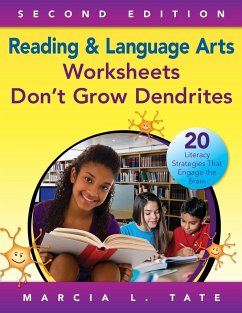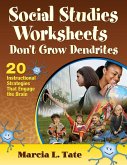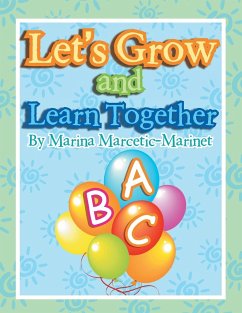Marcia L. Tate
Reading and Language Arts Worksheets Don't Grow Dendrites
20 Literacy Strategies That Engage the Brain
Marcia L. Tate
Reading and Language Arts Worksheets Don't Grow Dendrites
20 Literacy Strategies That Engage the Brain
- Broschiertes Buch
- Merkliste
- Auf die Merkliste
- Bewerten Bewerten
- Teilen
- Produkt teilen
- Produkterinnerung
- Produkterinnerung
Brain-based strategies turn reluctant readers into motivated learners!
Andere Kunden interessierten sich auch für
![Social Studies Worksheets Don't Grow Dendrites Social Studies Worksheets Don't Grow Dendrites]() Marcia L. TateSocial Studies Worksheets Don't Grow Dendrites37,99 €
Marcia L. TateSocial Studies Worksheets Don't Grow Dendrites37,99 €![Let's Grow and Learn Together Let's Grow and Learn Together]() Marina Marcetic-MarinetLet's Grow and Learn Together22,99 €
Marina Marcetic-MarinetLet's Grow and Learn Together22,99 €![A Journey With Ruben to See Why the Curtain Was Torn: Books to grow on A Journey With Ruben to See Why the Curtain Was Torn: Books to grow on]() Frances Gonzales MartinezA Journey With Ruben to See Why the Curtain Was Torn: Books to grow on13,99 €
Frances Gonzales MartinezA Journey With Ruben to See Why the Curtain Was Torn: Books to grow on13,99 €![The Means to Grow Up The Means to Grow Up]() Robert HalpernThe Means to Grow Up68,99 €
Robert HalpernThe Means to Grow Up68,99 €![I Want To Be A Custodian... When I Grow UP! I Want To Be A Custodian... When I Grow UP!]() James C BaileyI Want To Be A Custodian... When I Grow UP!18,99 €
James C BaileyI Want To Be A Custodian... When I Grow UP!18,99 €![Transitions: Helping Your Child Grow and Develop Transitions: Helping Your Child Grow and Develop]() Karen Zimmerman Ph. D.Transitions: Helping Your Child Grow and Develop33,99 €
Karen Zimmerman Ph. D.Transitions: Helping Your Child Grow and Develop33,99 €![When I Grow Up . . . If I Grow Up When I Grow Up . . . If I Grow Up]() Sonia RichmondWhen I Grow Up . . . If I Grow Up30,99 €
Sonia RichmondWhen I Grow Up . . . If I Grow Up30,99 €-
-
-
Produktdetails
- Produktdetails
- Verlag: Corwin
- 2. Auflage
- Seitenzahl: 200
- Erscheinungstermin: 5. November 2013
- Englisch
- Abmessung: 280mm x 216mm x 11mm
- Gewicht: 518g
- ISBN-13: 9781452280301
- ISBN-10: 1452280304
- Artikelnr.: 39304743
- Herstellerkennzeichnung
- Libri GmbH
- Europaallee 1
- 36244 Bad Hersfeld
- gpsr@libri.de
- Verlag: Corwin
- 2. Auflage
- Seitenzahl: 200
- Erscheinungstermin: 5. November 2013
- Englisch
- Abmessung: 280mm x 216mm x 11mm
- Gewicht: 518g
- ISBN-13: 9781452280301
- ISBN-10: 1452280304
- Artikelnr.: 39304743
- Herstellerkennzeichnung
- Libri GmbH
- Europaallee 1
- 36244 Bad Hersfeld
- gpsr@libri.de
Marcia L. Tate, EdD, is the former executive director of professional development for the DeKalb County School System in Decatur, Georgia. During her thirty-year career with the district, she has been a classroom teacher, reading specialist, language arts coordinator, and staff development executive director. Marcia is currently an educational consultant and has taught over 500,000 administrators, teachers, parents, and business and community leaders throughout the world. She is the author of the eight books in the best-selling Worksheets Don't Grow Dendrites series and four additional books: Formative Assessment in a Brain-Compatible Classroom: How Do We Really Know They're Learning?, 100 Brain-Friendly Lessons for Unforgettable Teaching and Learning K-8, and 100 Brain-Friendly Lessons for Unforgettable Teaching and Learning 9-12, and her latest book, Healthy Teachers, Happy Classrooms that is designed to address both the personal and professional lives of all educators. Participants in her workshops refer to them as some of the best ones they have ever experienced since Marcia uses the twenty strategies outlined in her books to actively engage her audiences. Marcia received her bachelor's degree in psychology and elementary education from Spelman College in Atlanta, Georgia. She earned her master's degree in remedial reading from the University of Michigan in Ann Arbor, her specialist degree in educational leadership from Georgia State University, and her doctorate in educational leadership from Clark Atlanta University. Marcia is married to Tyrone Tate and is the proud mother of three children: Jennifer, Jessica, and Christopher, and nine grandchildren: Christian, Aidan, Maxwell, Aaron, Roman, Shiloh, Aya, Noah, and Alyssa. Marcia and her husband own the company Developing Minds, Inc. and can be contacted by calling the company at (770) 918-5039, emailing her at marciata@ bellsouth.net, or by visiting her website at www.developingmindsinc.com. You can also follow her on Twitter and Instagram at @DrMarciaTate.
Acknowledgments
About the Author
Introduction
Strategy 1: Brainstorming and Discussion
What: Defining the Strategy
Why: Theoretical Framework
How: Instructional Activities
Reflection and Application
Strategy 2: Drawing and Artwork
What: Defining the Strategy
Why: Theoretical Framework
How: Instructional Activities
Reflection and Application
Strategy 3: Field Trips
What: Defining the Strategy
Why: Theoretical Framework
How: Instructional Activities
Reflection and Application
Strategy 4: Games
What: Defining the Strategy
Why: Theoretical Framework
How: Instructional Activities
Reflection and Application
Strategy 5: Graphic Organizers, Semantic Maps, and Word Webs
What: Defining the Strategy
Why: Theoretical Framework
How: Instructional Activities
Reflection and Application
Strategy 6: Humor
What: Defining the Strategy
Why: Theoretical Framework
How: Instructional Activities
Reflection and Application
Strategy 7: Manipulatives, Experiments, Labs, and Models
What: Defining the Strategy
Why: Theoretical Framework
How: Instructional Activities
Reflection and Application
Strategy 8: Metaphors, Analogies, and Similes
What: Defining the Strategy
Why: Theoretical Framework
How: Instructional Activities
Reflection and Application
Strategy 9: Mnemonic Devices
What: Defining the Strategy
Why: Theoretical Framework
How: Instructional Activities
Reflection and Application
Strategy 10: Movement
What: Defining the Strategy
Why: Theoretical Framework
How: Instructional Activities
Reflection and Application
Strategy 11: Music, Rhythm, Rhyme, and Rap
What: Defining the Strategy
Why: Theoretical Framework
How: Instructional Activities
Reflection and Application
Strategy 12: Project-Based and Problem-Based Instruction
What: Defining the Strategy
Why: Theoretical Framework
How: Instructional Activities
Reflection and Application
Strategy 13: Reciprocal Teaching and Cooperative Learning
What: Defining the Strategy
Why: Theoretical Framework
How: Instructional Activities
Reflection and Application
Strategy 14: Role Plays, Drama, Pantomimes, and Charades
What: Defining the Strategy
Why: Theoretical Framework
How: Instructional Activities
Reflection and Application
Strategy 15: Storytelling
What: Defining the Strategy
Why: Theoretical Framework
How: Instructional Activities
Reflection and Application
Strategy 16: Technology
What: Defining the Strategy
Why: Theoretical Framework
How: Instructional Activities
Reflection and Application
Strategy 17: Visualization and Guided Imagery
What: Defining the Strategy
Why: Theoretical Framework
How: Instructional Activities
Reflection and Application
Strategy 18: Visuals
What: Defining the Strategy
Why: Theoretical Framework
How: Instructional Activities
Reflection and Application
Strategy 19: Work Study and Apprenticeships
What: Defining the Strategy
Why: Theoretical Framework
How: Instructional Activities
Reflection and Application
Strategy 20: Writing and Journals
What: Defining the Strategy
Why: Theoretical Framework
How: Instructional Activities
Reflection and Application
Resource A: Brain-Compatible Lesson Design
Resource B: Graphic Organizers
Bibliography
Index
About the Author
Introduction
Strategy 1: Brainstorming and Discussion
What: Defining the Strategy
Why: Theoretical Framework
How: Instructional Activities
Reflection and Application
Strategy 2: Drawing and Artwork
What: Defining the Strategy
Why: Theoretical Framework
How: Instructional Activities
Reflection and Application
Strategy 3: Field Trips
What: Defining the Strategy
Why: Theoretical Framework
How: Instructional Activities
Reflection and Application
Strategy 4: Games
What: Defining the Strategy
Why: Theoretical Framework
How: Instructional Activities
Reflection and Application
Strategy 5: Graphic Organizers, Semantic Maps, and Word Webs
What: Defining the Strategy
Why: Theoretical Framework
How: Instructional Activities
Reflection and Application
Strategy 6: Humor
What: Defining the Strategy
Why: Theoretical Framework
How: Instructional Activities
Reflection and Application
Strategy 7: Manipulatives, Experiments, Labs, and Models
What: Defining the Strategy
Why: Theoretical Framework
How: Instructional Activities
Reflection and Application
Strategy 8: Metaphors, Analogies, and Similes
What: Defining the Strategy
Why: Theoretical Framework
How: Instructional Activities
Reflection and Application
Strategy 9: Mnemonic Devices
What: Defining the Strategy
Why: Theoretical Framework
How: Instructional Activities
Reflection and Application
Strategy 10: Movement
What: Defining the Strategy
Why: Theoretical Framework
How: Instructional Activities
Reflection and Application
Strategy 11: Music, Rhythm, Rhyme, and Rap
What: Defining the Strategy
Why: Theoretical Framework
How: Instructional Activities
Reflection and Application
Strategy 12: Project-Based and Problem-Based Instruction
What: Defining the Strategy
Why: Theoretical Framework
How: Instructional Activities
Reflection and Application
Strategy 13: Reciprocal Teaching and Cooperative Learning
What: Defining the Strategy
Why: Theoretical Framework
How: Instructional Activities
Reflection and Application
Strategy 14: Role Plays, Drama, Pantomimes, and Charades
What: Defining the Strategy
Why: Theoretical Framework
How: Instructional Activities
Reflection and Application
Strategy 15: Storytelling
What: Defining the Strategy
Why: Theoretical Framework
How: Instructional Activities
Reflection and Application
Strategy 16: Technology
What: Defining the Strategy
Why: Theoretical Framework
How: Instructional Activities
Reflection and Application
Strategy 17: Visualization and Guided Imagery
What: Defining the Strategy
Why: Theoretical Framework
How: Instructional Activities
Reflection and Application
Strategy 18: Visuals
What: Defining the Strategy
Why: Theoretical Framework
How: Instructional Activities
Reflection and Application
Strategy 19: Work Study and Apprenticeships
What: Defining the Strategy
Why: Theoretical Framework
How: Instructional Activities
Reflection and Application
Strategy 20: Writing and Journals
What: Defining the Strategy
Why: Theoretical Framework
How: Instructional Activities
Reflection and Application
Resource A: Brain-Compatible Lesson Design
Resource B: Graphic Organizers
Bibliography
Index
Acknowledgments
About the Author
Introduction
Strategy 1: Brainstorming and Discussion
What: Defining the Strategy
Why: Theoretical Framework
How: Instructional Activities
Reflection and Application
Strategy 2: Drawing and Artwork
What: Defining the Strategy
Why: Theoretical Framework
How: Instructional Activities
Reflection and Application
Strategy 3: Field Trips
What: Defining the Strategy
Why: Theoretical Framework
How: Instructional Activities
Reflection and Application
Strategy 4: Games
What: Defining the Strategy
Why: Theoretical Framework
How: Instructional Activities
Reflection and Application
Strategy 5: Graphic Organizers, Semantic Maps, and Word Webs
What: Defining the Strategy
Why: Theoretical Framework
How: Instructional Activities
Reflection and Application
Strategy 6: Humor
What: Defining the Strategy
Why: Theoretical Framework
How: Instructional Activities
Reflection and Application
Strategy 7: Manipulatives, Experiments, Labs, and Models
What: Defining the Strategy
Why: Theoretical Framework
How: Instructional Activities
Reflection and Application
Strategy 8: Metaphors, Analogies, and Similes
What: Defining the Strategy
Why: Theoretical Framework
How: Instructional Activities
Reflection and Application
Strategy 9: Mnemonic Devices
What: Defining the Strategy
Why: Theoretical Framework
How: Instructional Activities
Reflection and Application
Strategy 10: Movement
What: Defining the Strategy
Why: Theoretical Framework
How: Instructional Activities
Reflection and Application
Strategy 11: Music, Rhythm, Rhyme, and Rap
What: Defining the Strategy
Why: Theoretical Framework
How: Instructional Activities
Reflection and Application
Strategy 12: Project-Based and Problem-Based Instruction
What: Defining the Strategy
Why: Theoretical Framework
How: Instructional Activities
Reflection and Application
Strategy 13: Reciprocal Teaching and Cooperative Learning
What: Defining the Strategy
Why: Theoretical Framework
How: Instructional Activities
Reflection and Application
Strategy 14: Role Plays, Drama, Pantomimes, and Charades
What: Defining the Strategy
Why: Theoretical Framework
How: Instructional Activities
Reflection and Application
Strategy 15: Storytelling
What: Defining the Strategy
Why: Theoretical Framework
How: Instructional Activities
Reflection and Application
Strategy 16: Technology
What: Defining the Strategy
Why: Theoretical Framework
How: Instructional Activities
Reflection and Application
Strategy 17: Visualization and Guided Imagery
What: Defining the Strategy
Why: Theoretical Framework
How: Instructional Activities
Reflection and Application
Strategy 18: Visuals
What: Defining the Strategy
Why: Theoretical Framework
How: Instructional Activities
Reflection and Application
Strategy 19: Work Study and Apprenticeships
What: Defining the Strategy
Why: Theoretical Framework
How: Instructional Activities
Reflection and Application
Strategy 20: Writing and Journals
What: Defining the Strategy
Why: Theoretical Framework
How: Instructional Activities
Reflection and Application
Resource A: Brain-Compatible Lesson Design
Resource B: Graphic Organizers
Bibliography
Index
About the Author
Introduction
Strategy 1: Brainstorming and Discussion
What: Defining the Strategy
Why: Theoretical Framework
How: Instructional Activities
Reflection and Application
Strategy 2: Drawing and Artwork
What: Defining the Strategy
Why: Theoretical Framework
How: Instructional Activities
Reflection and Application
Strategy 3: Field Trips
What: Defining the Strategy
Why: Theoretical Framework
How: Instructional Activities
Reflection and Application
Strategy 4: Games
What: Defining the Strategy
Why: Theoretical Framework
How: Instructional Activities
Reflection and Application
Strategy 5: Graphic Organizers, Semantic Maps, and Word Webs
What: Defining the Strategy
Why: Theoretical Framework
How: Instructional Activities
Reflection and Application
Strategy 6: Humor
What: Defining the Strategy
Why: Theoretical Framework
How: Instructional Activities
Reflection and Application
Strategy 7: Manipulatives, Experiments, Labs, and Models
What: Defining the Strategy
Why: Theoretical Framework
How: Instructional Activities
Reflection and Application
Strategy 8: Metaphors, Analogies, and Similes
What: Defining the Strategy
Why: Theoretical Framework
How: Instructional Activities
Reflection and Application
Strategy 9: Mnemonic Devices
What: Defining the Strategy
Why: Theoretical Framework
How: Instructional Activities
Reflection and Application
Strategy 10: Movement
What: Defining the Strategy
Why: Theoretical Framework
How: Instructional Activities
Reflection and Application
Strategy 11: Music, Rhythm, Rhyme, and Rap
What: Defining the Strategy
Why: Theoretical Framework
How: Instructional Activities
Reflection and Application
Strategy 12: Project-Based and Problem-Based Instruction
What: Defining the Strategy
Why: Theoretical Framework
How: Instructional Activities
Reflection and Application
Strategy 13: Reciprocal Teaching and Cooperative Learning
What: Defining the Strategy
Why: Theoretical Framework
How: Instructional Activities
Reflection and Application
Strategy 14: Role Plays, Drama, Pantomimes, and Charades
What: Defining the Strategy
Why: Theoretical Framework
How: Instructional Activities
Reflection and Application
Strategy 15: Storytelling
What: Defining the Strategy
Why: Theoretical Framework
How: Instructional Activities
Reflection and Application
Strategy 16: Technology
What: Defining the Strategy
Why: Theoretical Framework
How: Instructional Activities
Reflection and Application
Strategy 17: Visualization and Guided Imagery
What: Defining the Strategy
Why: Theoretical Framework
How: Instructional Activities
Reflection and Application
Strategy 18: Visuals
What: Defining the Strategy
Why: Theoretical Framework
How: Instructional Activities
Reflection and Application
Strategy 19: Work Study and Apprenticeships
What: Defining the Strategy
Why: Theoretical Framework
How: Instructional Activities
Reflection and Application
Strategy 20: Writing and Journals
What: Defining the Strategy
Why: Theoretical Framework
How: Instructional Activities
Reflection and Application
Resource A: Brain-Compatible Lesson Design
Resource B: Graphic Organizers
Bibliography
Index









